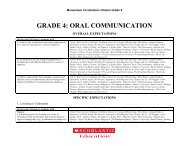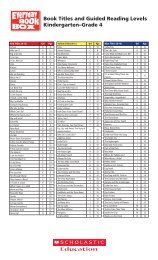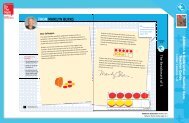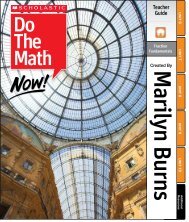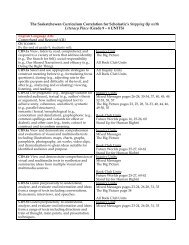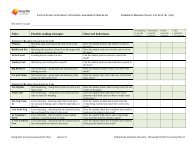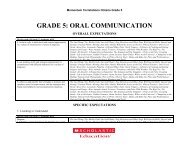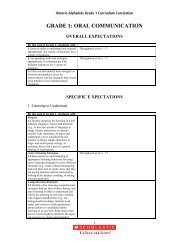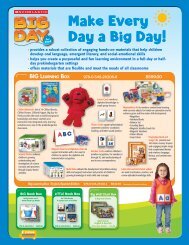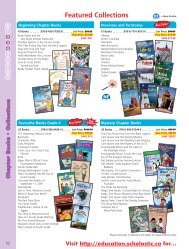Scope and Sequence Early Reading Stage Guided Reading Levels E–F
Levels E-F Early Reading - Scholastic Education
Levels E-F Early Reading - Scholastic Education
You also want an ePaper? Increase the reach of your titles
YUMPU automatically turns print PDFs into web optimized ePapers that Google loves.
<strong>Scope</strong> <strong>and</strong> <strong>Sequence</strong> <strong>Early</strong> <strong>Reading</strong> <strong>Stage</strong>: <strong>Guided</strong> <strong>Reading</strong> <strong>Levels</strong> <strong>E–F</strong>TitleHigh-FrequencyWords: NewHigh-Frequency Words: Revisited Key Vocabulary: New Key Vocabulary: Revisited Decodable Words: New Decodable Words: Revisited Possible <strong>Reading</strong> StrategiesThese suggestions are indicative only. There aremany opportunities for addressing a range ofreading strategies in each book.<strong>Early</strong> <strong>Reading</strong> <strong>Stage</strong>: Level E (7)InsectsWord count: 183all an do has have no not yes ant bee butterfly ladybug spiderworm bird two six eightwings insect/s legs • Underst<strong>and</strong>ing <strong>and</strong> reading a question <strong>and</strong>answer bookWhere Are theGrapes?Word count: 187know whichwouldan are but do for has have no not of saidsaw so that the then there they too whereyesant/s bee bird butterfly wormgrapes sixanimals crack kept fit madetracks wingsinsect/s into legs lots mud must • Drawing inferences – carrying meaningfrom one page to the nextSquidWord count: 130be eat fromif orall are get little make of out put theirthem then there theyblack green red yellow swim fishwatereggs hide ink lives off rockssea skin squidbig cannot into lots plants • <strong>Reading</strong> a report <strong>and</strong> using an indexBig Squid <strong>and</strong>Little SquidWord count: 239The Plum TreeWord count: 182eat just wereeat/s frommanyare big but did he little make no not nowput said saw that then they us where willare for make of out put/s that their theytooblack green red fish water playingant/s bee/s butterfly caterpillar/sbird/s flowers treehide ink let’s made sea skinsquid yelledanimals grub/s need leaveseggs feed plum/s sapcan’t help into plants • Using punctuation to support readinginsect/s nest • Checking pictures <strong>and</strong> labels to supportreadingMy TreeWord count: 153eat if onebut has make no not said so then tooyourant/s bee/s caterpillar/s birdflowers treegrub/s need leaves plum/ssap thingnest • Using letter cues<strong>Early</strong> <strong>Reading</strong> <strong>Stage</strong>: Level E (8)When the SunComes UpWord count: 165eat/s manywhendo for gets have little make/s of thenthey up willbird rabbit duck spider/s worm/scatch jump/s sleeps swims waterunderanimals bat bugs dives holehunts keep leaves safe sitsthings twigs wakefox frog insects into log lotsnest plants pond spins sun web• Using letter cues – Does it look right?When the Sun IsGoing DownWord count: 261Our SpotWord count: 228eat/ing whenboys daygood one ourwere whenam but do down for get going have littleno not now said so up yesall are but came did do for get have nonot now of said saw so that then therethey too was what where will yesbird rabbit duck spider wormssleep swim motherbat bugs dive hunting keepneed sing still time wakefirst played play/ing rope school hit jumped jump/ing samespot time today upsetbed fox must nest sun web • Using letter cues – scanning the word tocheck for the final lettercan’t flat let’s next • <strong>Reading</strong> punctuation marksWhere Can WePlay?Word count: 233be day goodher knowlong new onevery wereworkedall came down had his make now of putsaid so their them then there they upcatch paint/ed play/ed storebulldozer build truck blue redyellow father motherback bricks cleaned dugfantastic gave hole jumplitter need/s off picked ropesafe skate spot stones swepttime upset weedsbig bag/s best can’t cut fix flatl<strong>and</strong> plants• Self-monitoring when an error is madeLooking AfterYour FrogsWord count: 167after bebefore eatgive goodhow if knowlongare but do for get have little make notout put so that them they up will yourwater jump swimcrickets eggs hole lid petsset sit something tadpolestank timecannot frog/s log must pondplant s<strong>and</strong>• Underst<strong>and</strong>ing how procedural texts workFrog's New PondWord count: 194eat good justnew verywerebut for had no not now of out said sawso that then there waswater wormshot kept need/ed rocks setthingsfrog insects lots plants ponds<strong>and</strong>• Using syntax to support reading - Does itsound tight?Flying Start to Literacy <strong>Scope</strong> <strong>and</strong> <strong>Sequence</strong> Chart <strong>Early</strong> <strong>Reading</strong> <strong>Levels</strong> E‐F Published by Scholastic Education ©Copyright 2010 EC Licensing Pty Ltd.
<strong>Scope</strong> <strong>and</strong> <strong>Sequence</strong> <strong>Early</strong> <strong>Reading</strong> <strong>Stage</strong>: <strong>Guided</strong> <strong>Reading</strong> <strong>Levels</strong> <strong>E–F</strong>TitleHigh-FrequencyWords: NewHigh-Frequency Words: Revisited Key Vocabulary: New Key Vocabulary: Revisited Decodable Words: New Decodable Words: Revisited Possible <strong>Reading</strong> StrategiesThese suggestions are indicative only. There aremany opportunities for addressing a range ofreading strategies in each book.<strong>Early</strong> <strong>Reading</strong> <strong>Stage</strong>: Level F (9)Bat RescueWord count: 238after day eatfrom if otherwhenare do down for get going not of output so that their them then they up willgrapes sleep tree/s overbats bite branches checkclose cloth feed figs freehang home keepleaves name net/s safe seesometimes take thingstrapped until wakewell wingshelp insects must plants settingstop stuck sun• <strong>Reading</strong> a text written in the first personSally <strong>and</strong> the BatsWord count: 249be day knowlong new werewhen wouldall but came did do for get had have nonot now of out put said she so that theirthem then there they this what willwater tree under fiveate awake back bad bangedbats bell cooked drum fireflapped hose jelly keepmade net off picked plum/srang smiled smoke wetwingscan’t planted trap• Using visual cues independentlyTeach Me HowWord count: 257eat her howotherdo for get out put she their them too upwhen where willelephant/’s lion/’s tiger/’s zebra/’sfish ants dogs mother/s playingjump run swim wateranimals chase chimp/’scrack creep cub dolphin/’sfeet grab hot hunt/s keepneed pick quickly rest rocksafe skin spot teach teeththings trunkdig into mud s<strong>and</strong>• Self-extending – being able to discover newthings independentlyLittle CubWord count: 272be day eathow know onewereall am but did do for get going hadhave his little my no not said saw sheso that their them there was what willyeselephant zebra ants mother/s catchrun playanimals chimp cub hungrysad safe stick teach/ingthings timefun must• Using meaning cues independentlyThe Jump RopeTeamWord count: 228after again anybe before daygood just onevery wouldall but did doing get going had havemake not of said saw so that then theywas were willjump/ed jumping mother schooltwocoach each fit home keepkept mistakes rest rope/ssometimes speak still teamtime tricks weekfun help kids lots next stop• Underst<strong>and</strong>ing the use of tense to supportreadingThe Fun RunWord count: 246after be day ifjust long veryall are but do for get have not of saidthen there they too was were willfirstlion tiger beach zoo jump/ed runoveranimals best began endfinish fit grinned hop keepline need rest pant/edpuff/ed time vet weekwinningfun log must ran stop win• Using visual cues to support reading<strong>Early</strong> <strong>Reading</strong> <strong>Stage</strong>: Level F (10)Animals that NeedMudWord count: 176eat/s frommany ordo down getting little makes of puts sothem then they toohippopotamus elephant turtle pigcatch wateranimals cold crab/s dusteggs hides hole hot keepsneed/s off safe see skinsoft thingscannot digs frog into mud neststops sun wet• <strong>Reading</strong> labels to get informationMud, Mud, Mud!Word count: 247again day fromgood her howknow one verywereall but came do down for getting makeno of put said so that then there too upwas what where willbirds elephant pig turtle waterjump/ed overanimals back bad bugscold crab dust eggs hillhot keeps need off sadsafe she skin trunkfrog lots help mud must nestpond sat stops sun• Using structure to support readingFlying Start to Literacy <strong>Scope</strong> <strong>and</strong> <strong>Sequence</strong> Chart <strong>Early</strong> <strong>Reading</strong> <strong>Levels</strong> E‐F Published by Scholastic Education ©Copyright 2010 EC Licensing Pty Ltd.
<strong>Scope</strong> <strong>and</strong> <strong>Sequence</strong> <strong>Early</strong> <strong>Reading</strong> <strong>Stage</strong>: <strong>Guided</strong> <strong>Reading</strong> <strong>Levels</strong> <strong>E–F</strong>TitleHigh-FrequencyWords: NewHigh-Frequency Words: Revisited Key Vocabulary: New Key Vocabulary: Revisited Decodable Words: New Decodable Words: Revisited Possible <strong>Reading</strong> StrategiesThese suggestions are indicative only. There aremany opportunities for addressing a range ofreading strategies in each book.Keeping SafeWord count: 190be eat fromjust knowmany othervery woulddown so that them there they wherebutterfly caterpillar spiders birdscatch twofeet hangs holds hide keepleaf moth safe seen snakestick stillanimals cannot frog helps insect/splant sit/s stop• Using semantic cues to decodeLooking forLunchWord count: 235any eat fromjust know longall am are did do for get not of out saidsaw so then there they too us will yesbutterfly caterpillar spider/s worm/sgreen tree bird underbrown eek feet hid hidehissed hungry keep leaflunch moth ouch rockscreeched sit snakesomething stick still timetuckanimals can’t forest frog/s insect/sinto leg let/’s log must pond satslid• Using meaning cues to reread <strong>and</strong> correctBig Ships NeedTugboatsWord count: 214by from longor other takevery whenworkare but get not out their them they boats ropes two three around back bump/ing close dockhitting need pads safely seaship/s soft strong teamthings time tugboatsbig help stop• <strong>Reading</strong> diagrams to add meaningThe TugboatTeamWord count: 264old other veryworkam are did going little not out said sawtheir then they toofirst second third boat/s yellow ropes two three back bumped dock each hitneed pads rocks sea ship/ssoft strong team tug/gedtugboat/sbig cannot help next sat• Self-monitoring when readingFlying Start to Literacy <strong>Scope</strong> <strong>and</strong> <strong>Sequence</strong> Chart <strong>Early</strong> <strong>Reading</strong> <strong>Levels</strong> E‐F Published by Scholastic Education ©Copyright 2010 EC Licensing Pty Ltd.





